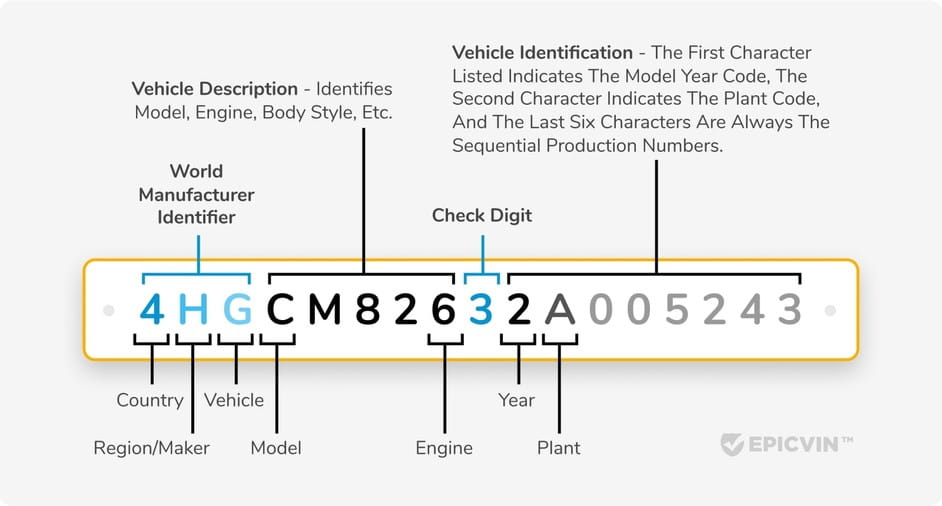
How to Read a VIN Number Like a Pro
From understanding the VIN number breakdown to uncovering a vehicle’s history,...

Free Ford VIN Decoder! 🚗 See specs, build sheet, recalls basic history—no sign-up. 🛡️✅ Need accidents, mileage, title? Upgrade in one click.
Looking for the VIN?
Here is there you’ll find it:

A Ford vehicle identification number (VIN) is a unique 17-character sequence. It contains letters and numbers that acts as your car’s fingerprint. Access the year, engine type, body style (sedan, truck, coupe), and trim level. Identify the manufacturing plant and safety issues with our VIN Decoder. Review specific car details and make informed decisions when buying a used car.
Our free VIN decoder provides instant access to your car's information in three simple steps:

Your VIN can be found in several locations::
Always verify the VIN matches across all locations. This helps avoid confusion when checking a specific vehicle.
| Risk Factor | Statistics |
|---|---|
| Share of cars with accident history | ≈ 34% of car reports contain ≥ 1 damage record |
| Salvage/Rebuild titles | ≈ 9% of cars have a salvage/rebuilt status |
| Average odometer data | 118,000 miles for 10+ year-old vehicles |
| Active recall campaigns 2025 | 45 cases in the first 5 months of 2025 (on track for ~128 per year) |
| Failure | Models, Symptoms, Average Repair Cost |
|---|---|
| PowerShift DCT | Fiesta 2011-16 and Focus 2012-16. They face jerking, delayed shifts, and premature clutch wear. Repair: $1,200-$3,000. |
| Spark plug ejection | F-150 2004-13 (5.4L) and 2011-20 (3.5L EcoBoost). Common issues are misfires, head thread damage. Repair: $400-$1,500. |
| EcoBoost coolant leaks | Edge, Escape, Fusion, F-150 2013-22. Owners mention block cracks, overheating. Repair: $6,000-$9,000. |

Every vehicle identification number (VIN) adheres to a standardized 17-letter-number format with specific positions:
| Symbols | Sample | What It Reveals |
|---|---|---|
| 1 | 1 | The United States as the country of origin |
| 2 | F | The Ford Motor Company as a manufacturer |
| 3 | T | Truck vehicle type/division |
| 4-8 | FW1ET | F-150 Regular Cab, 4x4 with 3.5L EcoBoost V6 engine |
| 9 | 5 | Check digit for VIN verification accuracy |
| 10 | D | 2013 year |
| 11 | F | Dearborn factory assembly plant |
| 12-17 | C12345 | Unique production sequence number |
Year 2011
Make Ford
Model Mustang
Fuel Type Gasoline
Engine 5L V-Shaped
Made in USA
Before you buy any used Ford, run the VIN through EpicVIN. In seconds, you'll see factory build specs, past accidents, PowerShift- or EcoBoost-related recalls, and title issues—hard facts that protect you from costly surprises.Alex Black, EpicVIN CMO
Yes. EpicVIN lets you run a basic VIN analysis at no cost. You'll instantly see build data such as engine, interior style, and assembly factory. You pay only if you decide to unlock the full vehicle-history information. It includes accidents, odometer readings, and title events.
Enter the VIN in EpicVIN and review the "Recalls" line. We query the NHTSA database in real time. Any active service campaigns will appear. You can also paste the same VIN into the Recall Lookup portal for double-verification.
On a window sticker, the VIN is near the top-left corner. It's above the barcode. Newer stickers also repeat the VIN along the bottom edge next to pricing details—find the label "VIN."
EpicVIN's VIN tool reads nearly every vehicle built since 1981. These are F-Series trucks, Mustang, Explorer, Escape, Bronco, Transit, the new Maverick hybrid, and other cars. If your VIN has the modern code, our decoder instantly reveals the vehicle's year, body style, engine code, interior, and assembly plant. Older classics (pre-1981) used shorter serials. Therefore, confirm the build year first. Run the VIN for free, then unlock a full EpicVIN history report. This comprehensive guide serves as your complete transportation resource.
Our VIN decoder works with nearly all vehicles. For older cars, the VIN may have fewer character positions and a different encoding. To check information for classic vehicles, confirm the year first. Then, cross-reference the decoded data with documentation. Our VIN decoder provides the most reliable results for modern passenger cars, SUVs, and trucks.
Discover expert tips, news and advice on buying and maintaining used vehicles

From understanding the VIN number breakdown to uncovering a vehicle’s history,...

Meet the hidden world of odometer fraud and read how to spot the signs of an o...

Discover essential insights on how flood damage affects vehicles, including re...